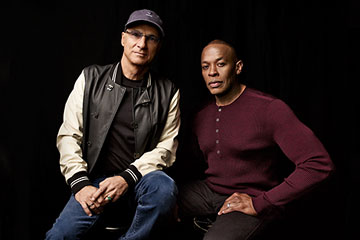
Rap's best-known producer masterminded the bass-heavy Beats sound.
(2 of 4)
Beats Music will have to compete with the likes of Spotify and Pandora, not to mention Apple and Google. To date, nobody has figured out a way to make much money from streaming. Even with royalty rates slashed to levels that make musicians howl, profits have been meager at best. Currently, the vast majority of subscribers are listening for free on ad-supported plans. But aside from a short trial period, Iovine won't be giving anything away for free.
To launch the music service, Beats has brought another pop star into the fold: Trent Reznor, the sulking mastermind behind Nine Inch Nails. Reznor, who has arranged the award-winning soundtracks of films like The Social Network and The Girl With the Dragon Tattoo in recent years, has been tasked with turning a piece of software people are used to getting for nothing into something they will want to pay a premium for. Which sounds daunting--until you consider that Beats is the company that got people to cast their free earbuds aside and pay a premium to replace them.
An Earful
There are two sets of speakers in a recording studio. One pair is tiny, the other is huge. The tiny ones are for the engineer and producer so they can hear clearly what is going on in the music. The big ones are for the musicians. They are tuned to sound as if the drum track could crush a city block or the singer is the second coming of Beyoncé. Audiophiles like headphones with sound like that of the tiny speakers--accurate. Traditionally, selling expensive headphones meant catering to them.
Then came a chance meeting between Dre and Iovine on Malibu's Carbon Beach in 2006. The rap kingpin was unhappy with his advisers. "They want me to sell sneakers," he complained to Iovine.
"F-ck sneakers," Iovine responded. "Let's sell speakers." The pair ultimately partnered with Monster, a manufacturer of high-end audio gear, to create a line of headphones.
Dre's insight was that even though finicky music fans want the tiny-speaker sound, most people would prefer the swaggering bravado of studio playback. Iovine, meanwhile, enlisted his network of stars to make the headphones cool. A succession of special editions--jewel-like Heartbeats by Lady Gaga meant to appeal to young girls, workout-oriented Powerbeats by LeBron James--helped the brand broaden its appeal.
The company also went to great lengths to make its products feel worth the price. It hired Robert Brunner, Apple's industrial-design director for most of the 1990s, to define the look and feel. That's why opening a new pair of Beats involves an elaborate ritual of unpacking. "I always felt that the buying and unveiling of something should have some drama about it," says Brunner. "We just want to make sure people felt like, Wow, I got something really special here."
